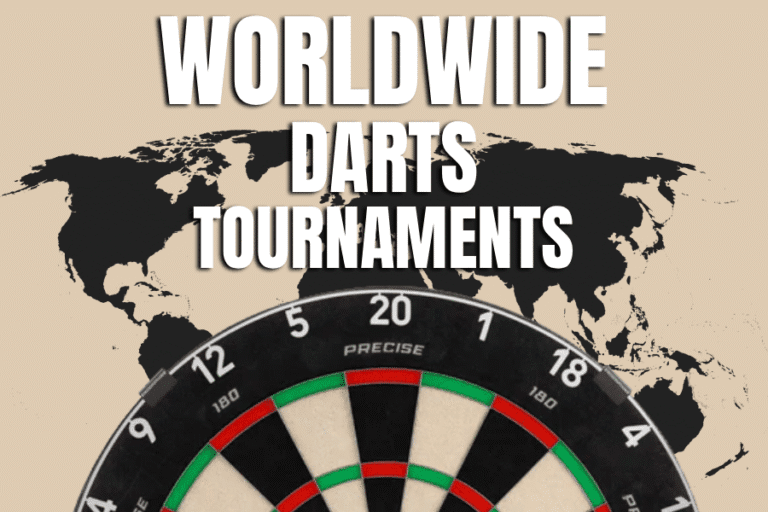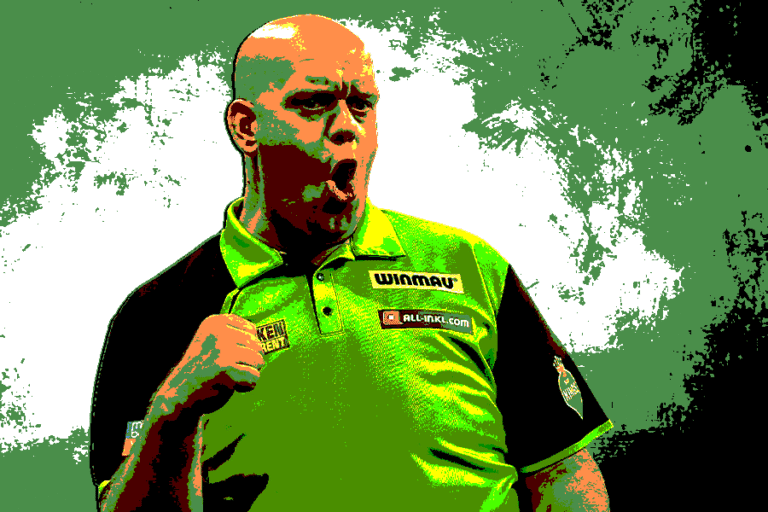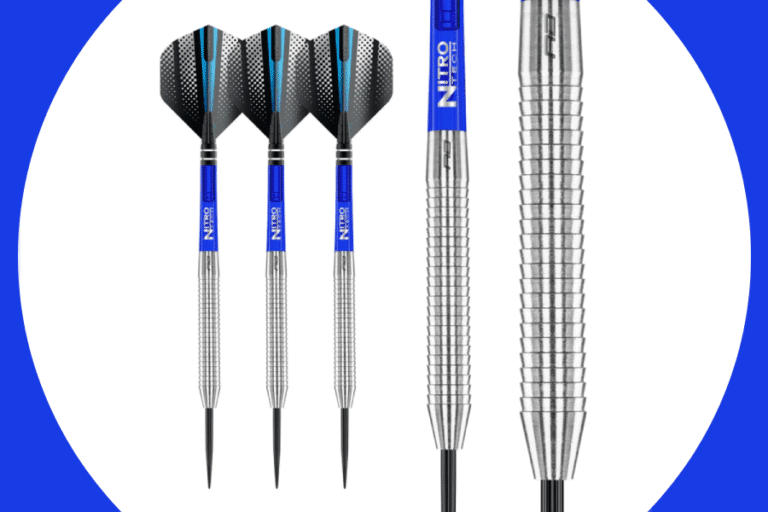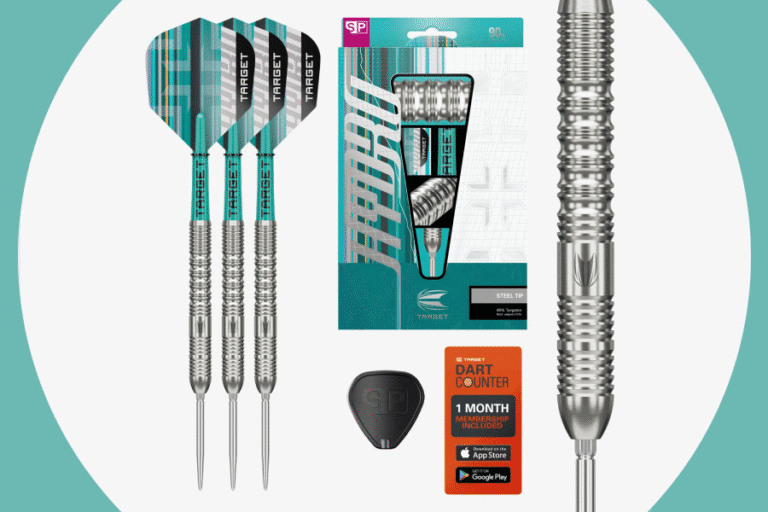
Darts, a game known for its blend of precision, strategy, and skill, has undergone a fascinating transformation from its ancient origins to the sophisticated sport it is today. Through the years, darts has evolved, influenced by advancements in materials and technology.
Through its evolution, it has seen the introduction of standardized dartboards, the development of steel-tipped darts, and significant changes in equipment, all contributing factors to the rise of darts!
Today, darts is a globally recognized sport with a rich history and a bright future. From its medieval roots to the modern era of professional tournaments and high-tech equipment, the evolution of darts reflects not only advancements in the game itself but also its growing popularity worldwide.
The Ancient Origins of Darts
The history of darts can be traced back to ancient civilizations where early forms of the game were played using rudimentary tools. These early versions of darts were far from the organized sport we recognize today, but they laid the foundation for what was to come. Ancient Greeks and Romans, for example, are believed to have used spears and other objects for similar games, targeting wooden or earth targets.
This early form of dart game showcased the basic principles of aiming and throwing, which are fundamental to the sport.

During the medieval period, darts evolved significantly. Soldiers used their downtime to engage in dart-like games, and these activities eventually spread to the general populace. The use of small, hand-held projectiles that were thrown at a target became a popular pastime.
This period saw the development of the first dartboards, often made from simple materials such as wood or cork. These early dartboards lacked the precision and durability of modern boards but were crucial in shaping the future of the game.
The Emergence of Modern Darts
The late 19th and early 20th centuries marked a significant turning point in the evolution of darts. During this period, the game began to take on a more recognizable form, thanks to key innovations in equipment and standardization.
The creation of the standardized dartboard, known as the “roundel,” provided a uniform target for players, which was essential for the development of competitive play. This standardization helped formalize the rules and set the stage for organized tournaments.
Another major development was the introduction of steel-tipped darts. Before this innovation, darts were typically made from wood or other materials with less precise tips. Steel-tipped darts offered improved accuracy and durability, making the game more competitive and enjoyable.
This change marked a significant advancement in dart technology, influencing how the game was played and perceived.
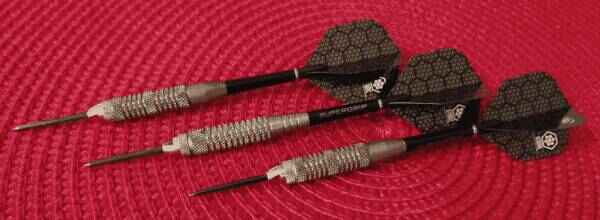
The Evolution of Darts Equipment
Advancements in dart equipment have played a crucial role in shaping the modern game. These innovations have made darts more accessible and enjoyable for players of all levels.
The evolution of dart barrels, shafts, and flights has introduced a range of designs and materials that cater to different playing styles and preferences.
Barrels: From Wood to Tungsten
Dart barrels have seen a remarkable evolution over the years. Originally made from wood, these barrels were replaced by materials like brass and nickel-silver. Today, tungsten has become the material of choice for high-quality darts.
Tungsten is incredibly dense, allowing for slimmer and more aerodynamic dart designs without sacrificing weight. This material’s strength and durability contribute to improved accuracy and consistency in gameplay.
The Red Dragon Pegasus are a great example of a modern set of darts. They are crafted from 80% tungsten. They are available in 21g, 24g, 26g, and up to 30g Steel Tip (18g & 20g Soft Tip).
They are straight, even-weighted darts with a serrated grip profile. The darts come with two sets of shafts, two sets of 100-micron flights, a point protector and dart wallet. LEARN MORE!

Shafts and Flights: Innovations and Variations
Shafts and flights have also undergone significant changes. Early shafts were made from wood or simple plastic, but modern shafts are crafted from materials like aluminum and carbon fiber.
Flights, which were once simple and uniform, now come in various shapes and materials, allowing players to choose designs that best suit their throwing style. These innovations in shafts and flights have enhanced dart performance, making the game more dynamic and customizable.
Precision Machining and CNC Technology
The advent of precision machining and CNC (Computer Numerical Control) technology has revolutionized the production of darts. CNC technology allows for precise shaping and consistent quality in dart barrels and tips.
This level of precision ensures that each dart performs similarly, which is crucial for competitive play. As a result, players can rely on their equipment to provide consistent results, enhancing their overall gameplay experience.

Dartboard Improvements
The evolution of dartboard materials and construction has been crucial in advancing the game. Early dartboards were made from materials like wood, cork, or simple fibers, which deteriorated over time and could affect gameplay.
Today, dartboards are predominantly constructed from high-quality sisal fibers. Sisal is a natural fiber that has the unique ability to heal itself after being punctured by darts. This self-healing property means that the dartboard maintains its playing surface and accuracy for a longer period compared to earlier materials.
In addition to material advancements, modern dartboards are designed with improved durability and performance features. For example, thin wiring is used in place of the traditional thick metal wires that surround the scoring areas on older boards.
This thin wiring, often made from materials like galvanized steel, reduces the number of bounce-outs—instances where the dart hits the wire and does not stick to the board. The improved design not only minimizes bounce-outs but also provides a more consistent and reliable scoring surface.
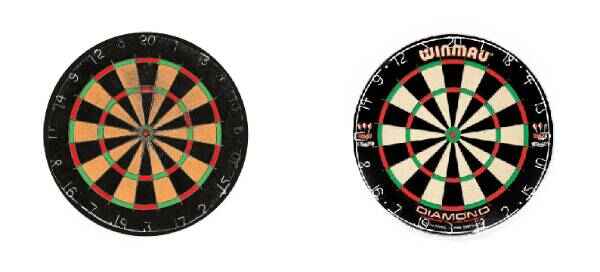
Dartboard Surrounds and Lighting Systems
To further enhance the playing environment, dartboard surrounds, and lighting systems have been introduced. Dartboard surrounds, which are usually made of soft, impact-resistant materials, are designed to protect walls and add an extra layer of safety.
They catch stray darts and prevent damage to the surrounding area. These surrounds also improve the overall aesthetic of the dartboard setup, creating a more polished and professional look.
Lighting systems, such as the Target Corona Vision and Shot! Stadium lighting plays a crucial role in optimizing visibility and reducing shadows on the dartboard. Proper lighting ensures that players can see the board clearly, which is essential for accuracy and consistency.
The lighting systems are often adjustable, allowing players to customize the illumination based on their preferences and the playing environment.
This focus on enhanced visibility contributes to a more enjoyable and competitive gameplay experience.
CLICK HERE to read my detailed review of the 4 Best Lighting Systems!
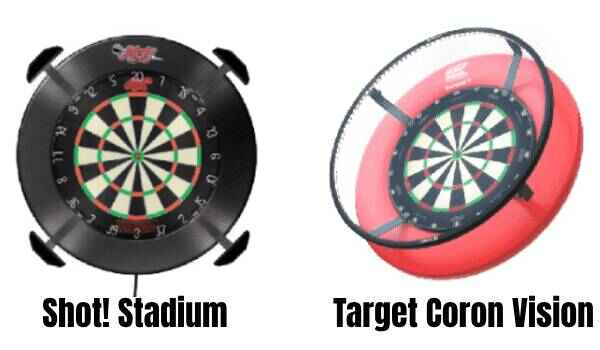
The Rise of Professional Darts
The growth of professional darts has transformed the game into a major global sport. Increased visibility and competitive opportunities have elevated the status of darts and attracted a wider audience.
The Evolution of Prize Money in Darts
The advancement of prize money in darts over the decades highlights the sport’s growing appeal and professionalization. In the early days, particularly in the 1970s and 1980s, darts tournaments offered relatively modest financial rewards.
For instance, the inaugural Embassy World Championship in 1978 had a total prize fund of £10,500, with the winner receiving £3,000. This was considered a significant sum at the time, yet it pales in comparison to the earnings in other sports.
Darts was still primarily a pub game, and while it had a dedicated following, it lacked the financial backing and media coverage needed to generate substantial prize funds.
The turning point for prize money in darts came with the formation of the Professional Darts Corporation (PDC) in 1992. The PDC brought a new level of professionalism and commercial acumen to the sport, attracting major sponsors and securing lucrative television deals.
As a result, prize money began to increase significantly. By the mid-2000s, the PDC World Darts Championship had grown to become the sport’s premier event, with prize funds reaching six figures.
The increase in prize money not only attracted a higher caliber of players but also elevated the sport’s status, drawing in more fans and media attention.
By 2024, prize money in darts has reached unprecedented levels. The PDC World Darts Championship now boasts a prize fund of £2.5 million, with the winner taking home £500,000.
This dramatic increase in prize money reflects the sport’s transformation into a global entertainment spectacle, with millions of fans tuning in to watch the world’s best players compete.
The financial rewards available in modern darts have made it a viable career for many, allowing players to focus solely on their craft and push the boundaries of the game.
The rise in prize money has not only enhanced the competitive nature of the sport but also solidified darts’ place as a major player in the world of professional sports.
The Formation of Darts Organizations
Key organizations like the Professional Darts Corporation (PDC) and the British Darts Organization (BDO) have been instrumental in organizing and promoting professional darts tournaments.
These organizations have established official rules, organized international competitions, and contributed to the sport’s global expansion. Their efforts have helped elevate darts to a professional level, attracting top players and enthusiastic fans from around the world.
Darts on TV and in the Media
Television coverage and media exposure have played a significant role in popularizing darts. Major tournaments are broadcasted globally, showcasing the sport’s excitement and drama.
The media coverage has introduced darts to new audiences, highlighting the skill and charisma of top players. This increased visibility has contributed to the sport’s growth and helped establish darts as a mainstream entertainment option.
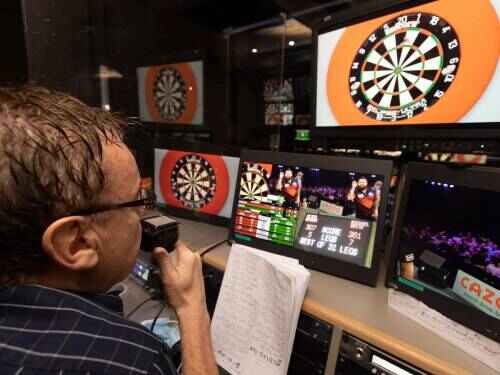
Technological Advancements in Darts
Technological advancements have significantly impacted the way darts is played and experienced. Innovations in equipment and technology have enhanced both training and gameplay.
Electronic Dartboards and Scoring Systems
Electronic dartboards and scoring systems have become increasingly popular for their convenience, accuracy, and enhanced features. These innovations have transformed the way players experience the game, offering automatic scoring, a variety of game options, and connectivity features.
Two notable examples in this category are the Viper 800 electronic dartboard, known for its advanced features and user-friendly design. And DartConnect, with its popular digital scoring and connectivity platform that enhances the dart-playing experience, especially for competitive players and leagues.
CLICK HERE To read my detailed review of the 4 Best electronic Dartboards!

Training Aids and Data Analytics
Training aids and data analytics have become essential tools for players seeking to improve their skills. Devices that measure throw accuracy and provide feedback on technique help players identify areas for improvement. Data analytics tools offer insights into performance trends and provide recommendations for enhancing gameplay. These technologies support players in reaching their full potential and achieving their goals.
Innovations in Dart Equipment
Recent innovations in dart equipment have introduced exciting new features and options for players. These advancements cater to various playing styles and preferences, enhancing the overall darting experience.
Ergonomic Grips and Customized Darts
Ergonomic grips and customized darts allow players to tailor their equipment to their specific needs. Grips designed for comfort and control help players achieve a more consistent throw. Customized darts, which can be adjusted for weight, balance, and grip style, enable players to create the perfect set of darts for their playing style. These innovations contribute to a more personalized and enjoyable game.
One-Piece Flight and Shaft Systems
One-piece flight and shaft systems, such as the Condor AXE and Mission Force 90, offer enhanced durability and performance. These systems integrate the flight and shaft into a single piece, reducing the risk of damage and improving aerodynamic stability. The seamless design of these systems ensures a more consistent flight path and better overall performance, making them popular choices among serious players.
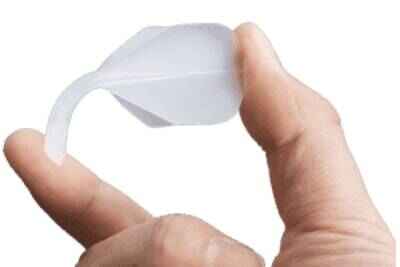
Darts in Different Continents
The spread of darts to different continents has brought new playing styles and cultural influences to the sport. In Europe, countries like the Netherlands, Germany, and the United Kingdom have long been strongholds of darts. The Netherlands, in particular, has produced several world-class players, contributing to the sport’s popularity across the continent. Germany has also seen a surge in darts enthusiasts, with the creation of a robust national league and the hosting of major tournaments.
In North America, darts has made significant strides, particularly in the United States and Canada. The formation of professional leagues and the introduction of televised tournaments have helped popularize the sport. The North American Darts Federation (NADF) and the American Darts Organization (ADO) work to promote darts across the continent, organizing events and supporting player development.
The sport has also gained traction in Asia and Oceania. Countries like Australia and New Zealand have established strong darts communities and host their own national and international tournaments. In Asia, nations such as Japan and China are increasingly involved in darts, with growing numbers of players and enthusiasts contributing to the sport’s expansion in the region.

Darts Leagues and Tournaments
One of the primary drivers behind the global expansion of darts is the establishment of international leagues and tournaments. The Professional Darts Corporation (PDC), founded in 1993, played a crucial role in internationalizing the sport. With its flagship event, the PDC World Darts Championship, attracting players from across the globe, the PDC has been instrumental in showcasing darts to a wider audience. This championship, held annually at London’s Alexandra Palace, features the world’s best players and garners significant media attention, elevating the sport’s profile on an international scale.
Similarly, the World Darts Federation (WDF) has played a significant role in promoting darts worldwide. The WDF organizes various international competitions and championships, providing a platform for players from different countries to compete. These events not only highlight the global talent pool but also foster international camaraderie and competition.
Cultural Impact and Grassroots Development
The global expansion of darts has had a profound cultural impact. In many countries, darts has become more than just a sport; it’s a social activity that brings people together. Local clubs and leagues offer opportunities for players of all skill levels to participate, fostering a sense of community and camaraderie.
Grassroots development programs have also played a crucial role in the sport’s expansion. Organizations and clubs around the world are working to introduce darts to younger generations, providing coaching and support to help them develop their skills. These programs are essential for sustaining the sport’s growth and ensuring a steady influx of new talent.
The Future of Global Expansion
Looking ahead, the future of darts’ global expansion seems promising. The sport’s increasing visibility through media coverage, international tournaments, and grassroots initiatives suggests that darts will continue to grow in popularity. As more countries embrace the game and invest in its development, darts is likely to see even greater global reach and influence. As darts continues to evolve, the future holds exciting developments and innovations that will shape the sport’s trajectory. The ongoing advancements promise to enhance the game and its experience for players and fans alike.
CLICK HERE to see my article about Darts in Asia!

Emerging Trends and Innovations
Emerging trends and innovations in darts include advancements in equipment design, new training methods, and improvements in game technology. These developments are expected to introduce new gameplay strategies and enhance the overall experience for players.
The Expansion of Online Play
The rise of online play has opened new opportunities for players to compete and connect. Online platforms offer a range of games and tournaments, allowing players to challenge opponents from around the world. This expansion has broadened the sport’s reach and made it more accessible to players of all skill levels.
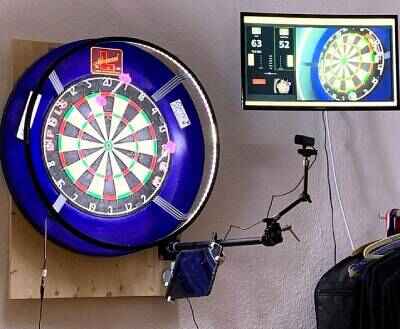
The Role of AI and Advanced Technologies
Artificial intelligence and advanced technologies are set to play a significant role in the future of darts. AI can provide insights into player performance and suggest improvements, while advanced technologies may lead to new equipment designs and gameplay enhancements. These innovations have the potential to revolutionize the sport and further elevate its appeal.
Looking Ahead: The Evolution of Darts
The journey of darts from its ancient origins to the modern game reflects the sport’s enduring appeal and continuous innovation. As darts continues to evolve, it promises to remain an exciting and dynamic sport, offering new challenges and opportunities for players around the world.
Frequently Asked Questions
What are the origins of darts?
Darts originated from ancient civilizations, with early forms of the game using spears and simple targets.
How did darts evolve into the modern game?
The game evolved through standardization of dartboards, the introduction of steel-tipped darts, and advancements in equipment.
What materials were used in early dart barrels?
Early dart barrels were made from wood, followed by materials like brass and nickel-silver.
What is the significance of tungsten in dart barrels?
Tungsten is dense and allows for slimmer, more durable dart barrels without sacrificing weight.
How have dartboards improved over the years?
Modern dartboards use high-quality sisal fibers for durability, improved visibility, and reduced bounce-outs.
What are one-piece flight and shaft systems?
One-piece systems, like the Condor AXE and Mission Force 90, integrate the flight and shaft into a single piece for better durability and performance.
How has electronic technology impacted darts?
Electronic dartboards offer automatic scoring and a range of built-in games, enhancing the playing experience.
What role does media coverage play in the popularity of darts?
Media coverage has increased the sport’s visibility, attracting new fans and showcasing top players.
What are some current trends in darts equipment?
Current trends include ergonomic grips, customized darts, and advanced training tools.
What does the future hold for darts?
The future of darts includes emerging trends in equipment design, advancements in technology, and the role of AI in enhancing gameplay.

